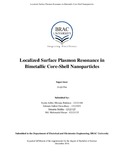| dc.contributor.advisor | Das, Avijit | |
| dc.contributor.author | Rahman, Syeda Adiba Mirzana | |
| dc.contributor.author | Chowdhury, Ishmam Salim | |
| dc.contributor.author | Siddha, Simanta | |
| dc.contributor.author | Hasan, Md. Mahmudul | |
| dc.date.accessioned | 2017-02-09T06:41:00Z | |
| dc.date.available | 2017-02-09T06:41:00Z | |
| dc.date.copyright | 2016 | |
| dc.date.issued | 2016-12 | |
| dc.identifier.other | ID 12121168 | |
| dc.identifier.other | ID 13121031 | |
| dc.identifier.other | ID 12121125 | |
| dc.identifier.other | ID 12121135 | |
| dc.identifier.uri | http://hdl.handle.net/10361/7735 | |
| dc.description | This thesis report is submitted in partial fulfillment of the requirements for the degree of Bachelor of Science in Electrical and Electronic Engineering, 2016. | en_US |
| dc.description | Cataloged from PDF version of thesis report. | |
| dc.description | Includes bibliographical references (page 58-62). | |
| dc.description.abstract | Colloidal nanoparticles have unique Localized Surface Plasmon Resonance (LSPR) properties. Various applications for LSPRs are in optics, photo catalysis, medicine and photovoltaics. For our research, we use the Mie Theory to analyze the LSPR properties of bimetallic core-shell nanoparticles in the shape of a sphere and consisting of Drude metals. We have come to see that there is a special LSPR mode in the interface between the two metals, i.e. the core and the shell, whose energy is concentrated at both the inner and the outer surfaces of the bimetallic nanoparticle. These phenomena are known as Ordinary Surface Plasmon Resonance and Extraordinary Surface Plasmon Resonance for the outer and inner surfaces respectively. The shape of the extinction spectrum and the shift of LSPR peak as a function of various geometric parameters are determined by both the Ordinary and Extraordinary LSPR modes together. When extended to practical noble metals such as Gold (Au) and Silver (Ag), we find that the SPR of Au@Ag (Gold core and Silver shell) nanoparticles can occur in the visible region with high tunability, which is beneficial to the enhancement of bio-sensing. Previous research has shown that Ordinary Plasmon Resonance can be used for bio-sensing by using one metal. In this paper, we will see that Extraordinary Plasmon Resonance can also be used to for bio-sensing. By changing the parameters of the core and the shell, and the substrate material, we will see the change in the Power Absorption curve, the electric field coupling, Sensitivity of the biomolecule and the SPR Shift. | en_US |
| dc.description.statementofresponsibility | Syeda Adiba Mirzana Rahman | |
| dc.description.statementofresponsibility | Ishmam Salim Chowdhury | |
| dc.description.statementofresponsibility | Simanta Siddha | |
| dc.description.statementofresponsibility | Md. Mahmudul Hasan | |
| dc.format.extent | 62 pages | |
| dc.language.iso | en | en_US |
| dc.publisher | BRAC University | en_US |
| dc.rights | BRAC University thesis are protected by copyright. They may be viewed from this source for any purpose, but reproduction or distribution in any format is prohibited without written permission. | |
| dc.subject | Surface Plasmon | en_US |
| dc.subject | Bimetallic core-shell | en_US |
| dc.subject | Localized Surface Plasmon Resonance (LSPR) | en_US |
| dc.title | Localized surface plasmon resonance in bimetallic core-shell nanoparticles | en_US |
| dc.type | Thesis | en_US |
| dc.contributor.department | Department of Electrical and Electronic Engineering, BRAC University | |
| dc.description.degree | B. Electrical and Electronic Engineering | |

